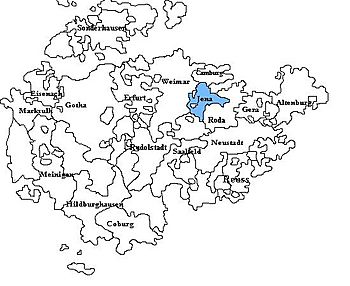Saxe-Jena facts for kids
Quick facts for kids
Duchy of Saxe-Jena
Herzogtum Sachsen-Jena
|
|||||||||
|---|---|---|---|---|---|---|---|---|---|
| 1672–1690 | |||||||||

Saxe-Jena, shown with the other Ernestine duchies
|
|||||||||
| Status | State of the Holy Roman Empire | ||||||||
| Capital | Jena | ||||||||
| Government | Principality | ||||||||
| Historical era | Middle Ages | ||||||||
|
• Partitioned from
Saxe-Weimar |
1672 1672 |
||||||||
|
• Ducal line extinct;
restored to Saxe-Weimar |
1690 1690 |
||||||||
|
|||||||||
The Duchy of Saxe-Jena was a small country that existed for a short time in what is now Germany. It was one of the Ernestine duchies, which were small states ruled by different branches of the House of Wettin family. These duchies were part of the larger Holy Roman Empire.
Contents
How Saxe-Jena Began
The Duchy of Saxe-Jena was created in 1672. It was formed when the existing Saxe-Weimar duchy was divided. This was a common practice among the Ernestine duchies. When a duke died, his land was often split among his sons.
Bernhard II Becomes Duke
In 1672, a part of Saxe-Weimar was given to Bernhard. He was the fourth son of Wilhelm, Duke of Saxe-Weimar. Bernhard became the first ruler, or "duke," of this new territory, which was named Saxe-Jena.
The End of the Duchy
The Duchy of Saxe-Jena did not last very long. It existed for only 18 years.
No Heirs to Inherit
When the second duke, Johann Wilhelm, died in 1690, he did not have any sons. In those times, only male children could inherit a title and land. Because there were no male heirs, the Duchy of Saxe-Jena could not continue as a separate state.
Rejoining Saxe-Weimar
After Johann Wilhelm's death, the territory of Saxe-Jena was returned to Saxe-Weimar. This meant it became part of the larger Saxe-Weimar duchy again.
Rulers of Saxe-Jena
Here are the two dukes who ruled the Duchy of Saxe-Jena during its short history:
The land was then reincorporated into Saxe-Weimar.
See also
 In Spanish: Ducado de Sajonia-Jena para niños
In Spanish: Ducado de Sajonia-Jena para niños

